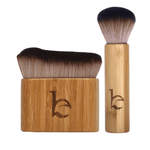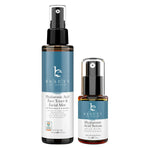Add More. Save More
LIMITED TIME OFFER

Self Tanner Kabuki Brush Set (DEAL)
$37.98$25.99

Hyaluronic Acid Duo Bundle (DEAL)
$67.98$46.89

Self Tanner Kabuki Brush Set (DEAL)
$37.98$25.99

Hyaluronic Acid Duo Bundle (DEAL)
$67.98$46.89
Are you ready? Let’s go!
“Formaldehyde,” you may say. “Isn’t that the stuff they used to preserve the frog I dissected in 10th grade bio?” Why yes, yes it is! You’ll find formaldehyde most commonly in hair straightening treatments, as well as some nail polish and eyelash glue. It’s legal to include in US made cosmetics, however it is banned in Europe. It’s a known carcinogen and can cause breathing issues.
Petroleum is derived from the same stuff that fuels your car. It goes by a few different names, including mineral oil, petrolatum, and paraffin oil. Experts question whether any of these ingredients are safe to use long term because your body doesn’t metabolize it. Whatever gets into your body just kind of… sits there. What does that mean over the long term? Who knows! Which is likely why it’s not used in the EU. Keep your eye out for petroleum in moisturizing products for lips and skin.

Parabens, known by many different names (including methylparaben, isopropylparaben, pentylparaben, isobutylparaben, phenylparaben, and benzylparaben) are a preservative I talk a lot about on this blog. They have a tendency to mimic estrogen in the body, wreaking havoc on your hormonal system. Their impact may even be enough to reduce fertility in men. Parabens are extremely common in conventional skin and hair products, so keep a sharp eye out for them whenever you shop.
Think about the last time you (or your child) took antibiotics. They worked great, right? Well, they may not be as effective next time if triclosan continues to be found in US products. This ingredient may be a part of the rise of antibiotic resistant bacteria – a very, very scary thought. Steer clear of this ingredient in soaps and toothpastes.

This ingredient is found in products designed to brighten or lighten the skin. It’s also bad, bad news. Europe and Japan have outlawed it due to its cytotoxic nature. Hydroquinone kills cells and chromosomes if it is used too much, which sets the stage for some forms of cancer. While high doses of hydroquinone are banned in the US, prescription level amounts of 4% are readily available. There’s no evidence that this dosage doesn’t lead to cancer, so it makes the most sense to avoid hydroquinone completely.
Otherwise known as PPD, this ingredient is derived from coal tar. It leads to (very severe) allergic reactions and can be found in a huge number of conventional hair dyes. The EU has banned it altogether, and I’d encourage you to ban it from your bathroom as well.

Manufacturers use Quaternium-15 to help their makeup last as long as possible. Which is all well and good, until you realize that it can release formaldehyde. Yup, the same stuff that causes cancer and breathing issues. You’re most likely to find this banned ingredient in facial cosmetics, especially powders.
Talc shows up in cosmetics and hair care products that help get rid of oil (dry shampoo, powdered makeup, deodorants and even baby powder). While it’s great at getting rid of grease, it’s also quite good at containing asbestos and increasing your risk of lung growths and mesothelioma. While there is strict quality control on talc in the United States, it’s much safer to take the route the EU chose and avoid it altogether.

Ah, my old friend “fragrance.” If you’ve spent much time on this blog at all, you know I’m particularly wary whenever I see this word on a label. Loopholes in US labeling regulations let manufacturers include just about any ingredient they want in a product under the umbrella term of “fragrance.” It keeps you from ever really knowing what’s in your products. The EU took the sensible route of closing up this loophole altogether.
Titanium nanoparticles are a common ingredient in conventional sunscreen. These particles do block UV rays, but because of their small size they’re also able to penetrate your skin. There is growing concern that these particles may have a toxic effect on the brain, increase your risk of nerve damage, and cause cancer. With risks like that, it makes sense that the EU would ban it!

Avobenzone is an interesting ingredient. It’s very unstable, and breaks down easily. When it does, it releases free radicals, destructive molecules that hurt your cells, cause early aging, and may even lead to cancer. You’re most likely to find it in sunscreen, so be sure to read your labels carefully before you buy.
There isn’t one clear answer about why so many of these clearly harmful ingredients are permitted in the United States. However, the fact that the FDA doesn’t have much power over the cosmetics industry at all has a lot to do with it. Unfortunately, there just isn’t much oversight into what goes into the products we use every day. It’s up to us to be mindful about which products we choose to use, and which ingredients we expose ourselves to.

Unless you’re planning on moving to Europe soon, here’s what I do to make sure I’m not letting toxic ingredients into my home:
You can find a full list of the chemicals banned in the EU here. While you definitely don’t need to memorize the list, it’s a good idea to know the ingredients that are most likely to pop up in the United States. The ingredients I’ve listed above are a great place to start – they’re the ones that are most common in US products.
You’ve heard me say it before, and you’ll hear me say it again – make sure you’re reading the labels before you buy anything that gets applied to your skin, lips, or hair. If it has something you don’t want in it, put it back down. We don’t expect you to understand all of the ingredients, so you can always use the EWG to help you. The Environmental Working Group has a great database just for cosmetics products. You can either check the complete product, or individual ingredients and get a safety rating for each.

Natural beauty products are extremely unlikely to contain ingredients banned in the EU. Instead, they’re made with ingredients that work even better. Beauty by Earth does all of this—never settling for the likes of toxins. Most natural beauty companies also choose to get their packaging and ingredients from sustainable sources. For instance, BBE uses recyclable paper cartons from FSC-certified forests. I definitely feel more confident that not only are natural products better for me and my family, they’re better for the environment too. And just because the name of the company indicates it is “natural” doesn’t mean it is. Always check your labels.

Demand is what determines what manufacturers make – and what they don’t. When you buy a bottle of shampoo filled with toxic chemicals, you’re not just inviting dangerous ingredients into your home, you’re also saying “I love how you’re making your shampoo! Please make more just like it!” The same goes for natural products. When you choose to purchase natural beauty products, you’re letting conventional brands know that you don’t like what they’re doing. The fewer people purchase items with toxic ingredients, the less incentive there is for businesses to make them. You have seen this a lot in the food industry recently.
There are a lot of cheap, sketchy, and downright toxic ingredients available on US shelves. And unlike Europe, we probably won’t be able to rely on regulations to keep them out of our homes. If you’re concerned about the products available to you and your family, it’s time to get smart about what you buy. Avoid dangerous chemicals, choose products that use natural ingredients, and stay informed about the different ingredients out there. Trust me – you’ll be glad you did!
Should my list contain other toxic ingredients that you are aware of? Let me know about it in the comments below!